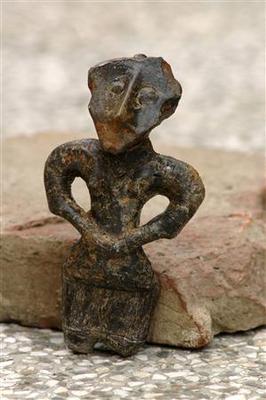
|
| ©REUTERS/Stevan Lazarevic |
| A Neolithic figurine shows a girl in a short skirt and ornate top, found in the Plocnik archaeological site near the town of Prokuplje in southern Serbia, Nov. 3, 2007. |
Recent excavations at the site -- part of the Vinca culture which was Europe's biggest prehistoric civilization -- point to a metropolis with a great degree of sophistication and a taste for art and fashion, archaeologists say.
In the Neolithic settlement in a valley nestled between rivers, mountains and forests in what is now southern Serbia, men rushed around a smoking furnace melting metal for tools. An ox pulled a load of ore, passing by an art workshop and a group of young women in short skirts.
"According to the figurines we found, young women were beautifully dressed, like today's girls in short tops and mini skirts, and wore bracelets around their arms," said archaeologist Julka Kuzmanovic-Cvetkovic.
The unnamed tribe who lived between 5400 and 4700 BC in the 120-hectare site at what is now Plocnik knew about trade, handcrafts, art and metallurgy. Near the settlement, a thermal well might be evidence of Europe's oldest spa.
"They pursued beauty and produced 60 different forms of wonderful pottery and figurines, not only to represent deities, but also out of pure enjoyment," said Kuzmanovic.
The findings suggest an advanced division of labor and organization. Houses had stoves, there were special holes for trash, and the dead were buried in a tidy necropolis. People slept on woolen mats and fur, made clothes of wool, flax and leather and kept animals.
The community was especially fond of children. Artifacts include toys such as animals and rattles of clay, and small, clumsily crafted pots apparently made by children at playtime.
COPPER AGE
One of the most exciting finds for archaeologists was the discovery of a sophisticated metal workshop with a furnace and tools including a copper chisel and a two-headed hammer and axe.
"This might prove that the Copper Age started in Europe at least 500 years earlier than we thought," Kuzmanovic said.
The Copper Age marks the first stage of humans' use of metal, with copper tools used alongside older stone implements. It is thought to have started around the 4th millennium BC in south-east Europe, and earlier in the Middle East.
The Vinca culture flourished from 5500 to 4000 BC on the territories of what is now Bosnia, Serbia, Romania and Macedonia.
It got its name from the present-day village of Vinca, 10 km east of Belgrade on the Danube river, where early 20th-century excavations uncovered the remains of eight Neolithic villages.
The discovery of a mine -- Europe's oldest -- at the nearby Mlava river suggested at the time that Vinca could be Europe's first metal culture, a theory now backed up by the Plocnik site.
"These latest findings show that the Vinca culture was from the very beginning a metallurgical culture," said archaeologist Dusan Sljivar of Serbia's National Museum. "They knew how to find minerals, to transport them and melt them into tools."
The metal workshop in Plocnik was a room of some 25 square meters, with walls built out of wood coated with clay.
The furnace, built on the outside of the room, featured earthen pipe-like air vents with hundreds of tiny holes in them and a prototype chimney to ensure air goes into the furnace to feed the fire and smoke comes out safely.
"In Bulgaria and Cyprus, where such workshops have also been found, they didn't have chimneys but blew air on the fire with straws, exposing man to heat and carbon dioxide," Sljivar said.
COLOURFUL MINERALS
He said the early metal workers very likely experimented with colorful minerals that caught their eye -- blue azurite, bright green malachite and red cuprite, all containing copper -- as evidenced by malachite traces found on the inside of a pot.
The settlement was destroyed at some point, probably in the first part of the fifth millennium, by a huge fire.
The Plocnik site was first discovered in 1927 when the then Kingdom of Serbs, Croats and Slovenes was building a rail line from the southern city of Nis to the province of Kosovo.
Some findings were published at the time but war, lack of funds and objections from farmers meant it was investigated only sporadically until digging started in earnest in 1996.
"The saddest thing for us is always the moment when we finish our work and everything has to be covered up with earth again," Kuzmanovic said. "That's the easiest for the state, conservation is very expensive and the land owners want to work in their fields."
But there was some hope that the latest excavation would be preserved due to its importance, Kuzmanovic added.
"We dream of uncovering the entire town one day, and people will be able to see prehistoric life at its fullest," she said.
(Editing by Ellie Tzortzi and Sara Ledwith)



It says in the article that the settlement was destroyed by a huge fire. One cosmic impact at around that time is coming from the Macha craters in Russia, which are estimated to be less than 7000 years old. The largest crater is 300 metres in diameter.Link
Could it be that it happened as part of a cyclical meteor shower and that one of the other bolides ignited huge fires in the area which caused the destruction of the above settlement?
It doesn't mean that the destruction was caused by a cosmic impact, but the description of the huge fire made me think of the description given in the book The cycle of Cosmic Catastrophes, outlining a likely scenario of the destruction 12900 years ago.